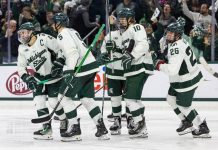Here’s the way the PairWise Rankings looked after the Beanpot games Monday:
1. Quinnipiac
2. St. Cloud State
3. North Dakota
4. Boston College
5. Providence
6. Michigan
7. Notre Dame
8. Boston University
9. Omaha
10. Yale
11. Harvard
12. Denver
13. Massachusetts-Lowell
14t. Cornell
— projected cut line —
14t. Penn State
16. Dartmouth
17. Clarkson
18. Minnesota-Duluth
19t. Robert Morris
— average position for outsider to make tournament —
19t. Michigan Tech
21t. Minnesota
21t. Rensselaer
23t. Bowling Green
— lowest any team has ever been ranked and still qualified —
23t. Minnesota State
25t. St. Lawrence
25t. Miami
27. Northeastern
28t. Ferris State
28t. Union
30. Northern Michigan
31. Air Force
32. Holy Cross
33t. New Hampshire
33t. Vermont
35. Western Michigan
36t. Ohio State
36t. Bemidji State
38. Wisconsin
39. Mercyhurst
40t. RIT
40t. Merrimack
42t. Bentley
42t. Colgate
44t. Connecticut
44t. Alaska-Anchorage
46t. Massachusetts
46t. Michigan State
46t. Maine
49t. Colorado College
49t. Army
51. Lake Superior
52. Princeton
53t. Brown
53t. Sacred Heart
55. Canisius
56. Alaska
57. Alabama-Huntsville
58. Niagara
59. Arizona State
60. American International
The Beanpot traditionally ends the nonconference portion of the college hockey schedule. This year, there are still some key nonconference games remaining involving highly-ranked teams, starting with Miami vs. Bowling Green this Friday. The winning team sets up as this season’s potential St. Cloud State. Last season, the Huskies were ranked No. 23 in the post-Beanpot PairWise and wound up going to the NCAA regional finals. St. Cloud became the lowest-ranked team at this point of the season to eventually qualify for the tournament.
In all, 10 teams that were ranked 20th or lower have made the tournament in the 13 years since expansion to 16 teams. The window is closing, but for teams like Minnesota-Duluth and Michigan Tech, it remains open ever so slightly.
Those teams are the exception. Over 89 percent of teams that are ranked 1-12 at the end of the Beanpot remain in the tournament field. Historically, the safe zone has expanded to the top six teams in the standings. The highest-ranked team to fall from the eventual field was ranked No. 7 overall, last done by the 2013 Western Michigan Broncos. In all, over 75 percent of teams currently above the cut line (still projected at 14) have made the tournament.
Those at the very top tend to stay at the very top. In eight of the 13 seasons, the overall No. 1 team has remained the overall No. 1 team. In 12 of those seasons, it has remained a No. 1 regional seed. Only the 2012 Ferris State Bulldogs fell to a No. 2 regional seed. In 2004, not only did all four teams remain in the top four, all four teams entered the NCAA tournament with the same ranking they had after the Beanpot. In all, 73 percent of the top four teams remain in the top four.
North Dakota remains the outlier here. In 2012, the then-Fighting Sioux were ranked 16th overall at the end of the Beanpot before finishing fourth overall. In fact, they were still ranked No. 13 on March 5 before defeating St. Cloud State, Minnesota and Denver to win the WCHA Final Five.
Not to be outdone, the next season UMass-Lowell limped into the Beanpot break with consecutive losses to Maine and Merrimack and was sitting 17th in the PairWise. The River Hawks then went on a 12-1 run, won the Hockey East championship, finished No. 3 overall and went to the Frozen Four.
So history tells us it can be done. Teams like St. Cloud State, the 2010 Northern Michigan Wildcats and 2007 Massachusetts Minutemen have accomplished it, but the odds are stacked very much against teams not already projected in the field.


